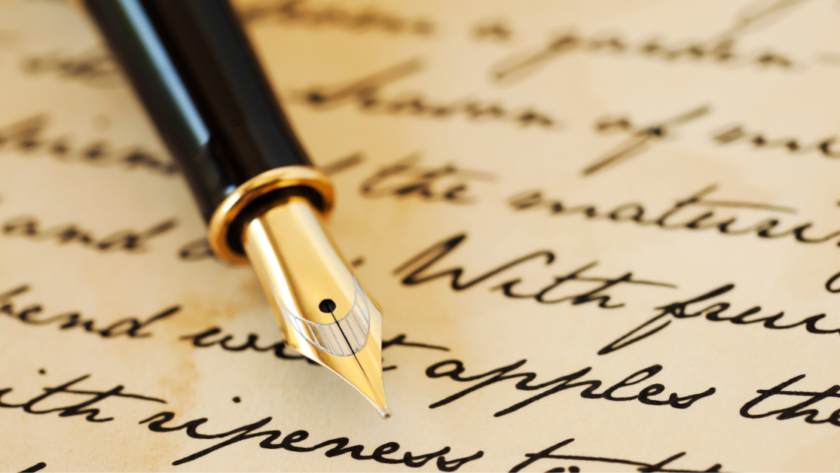The right pen can improve your journaling experience, making it efficient to transfer thoughts to paper. In this comprehensive guide, I’ll share my top picks for smooth-writing pens and provide insights to help you choose the best tool for your journaling needs.
Understanding Pen Smoothness
The smoothness of a pen depends on several factors:
Ink Formulation
The type and quality of ink significantly impact how a pen writes. Gel inks tend to flow more freely than traditional ballpoint inks, resulting in a smoother writing experience.
The viscosity of the ink plays a crucial role – thinner inks generally flow more easily, while thicker inks can provide more control.
Tip Design
The size and shape of the pen tip affect how ink is distributed onto the paper. A well-designed tip confirms consistent ink flow and smooth lines.
Finer tips can offer more precision but may feel less smooth than broader tips.
Paper Interaction
The smoothness of your writing surface greatly influences pen performance. Higher-quality papers with smoother textures allow pens to glide more easily, enhancing the overall writing experience.
This is why many journalers invest in premium notebooks alongside their favorite pens.
Gel Pens: Smooth Operators
Gel pens are renowned for their smooth writing capabilities. Their water-based gel ink flows efficiently, creating crisp, vibrant lines with minimal pressure.
This makes them ideal for extended writing sessions, as they reduce hand fatigue.
Top Gel Pen Picks
- Pilot G2
The Pilot G2 is a classic choice for good reason. It’s comfortable grip and consistent ink flow make it a favorite among journalers and office workers alike.
The G2 comes in various tip sizes, from 0.38mm to 1.0mm, allowing you to choose the perfect line width for your writing style.
- Pentel EnerGel
The Pentel EnerGel stands out for it’s quick-drying ink, making it an excellent choice for left-handed writers who struggle with smudging. The smooth ink flow and comfortable grip make it a joy to use for long writing sessions.
- Uni-ball Signo DX
For those who prefer finer lines, the Uni-ball Signo DX offers the smoothness of gel ink with the precision of a needle-point tip. It’s perfect for detailed note-taking and intricate journaling layouts.
Fountain Pens: The Customizable Classic
Fountain pens offer a luxurious writing experience with unparalleled smoothness. The liquid ink flows freely, requiring minimal pressure and resulting in efficient writing.
While they may seem intimidating at first, fountain pens can be an excellent choice for journalers looking to elevate their writing experience.
Beginner-Friendly Fountain Pens
- It’s affordable, reliable, and writes smoothly right out of the box.
The ergonomic grip makes it comfortable for extended writing sessions.
- Pilot Metropolitan
For a step up in quality without breaking the bank, the Pilot Metropolitan offers a refined writing experience. It’s medium nib provides a smooth, consistent line, and the metal body gives it a premium feel.
Advantages of Fountain Pens
One of the biggest perks of using fountain pens is the ability to switch inks. This allows you to personalize your journaling experience and even use different colors to organize your thoughts.
Additionally, the minimal pressure required can reduce hand fatigue during long writing sessions.
Rollerball Pens: The Best of Both Worlds
Rollerball pens mix the smooth writing of gel pens with the reliability of ballpoints. They use liquid ink similar to fountain pens but with a ball-point delivery system, resulting in a consistently smooth line.
Top Rollerball Picks
- Uni-ball Vision Elite
The Uni-ball Vision Elite stands out for it’s skip-free writing and vibrant, long-lasting ink. The unique “uni-flow” ink system confirms consistent ink flow, even when writing at odd angles.
- Pilot Precise V5
For those who prefer finer lines, the Pilot Precise V5 delivers exceptional precision without sacrificing smoothness. It’s needle-point tip creates crisp, clean lines ideal for detailed journaling.
Unexpected Smooth Writers
While gel, fountain, and rollerball pens are known for their smoothness, there are some unexpected contenders worth considering:
Felt-tip Pens
The Papermate Flair offers a uniquely smooth writing experience with it’s porous tip. It’s perfect for those who enjoy a slightly softer feel when writing and works well for both writing and sketching in your journal.
Hybrid Ballpoints
The Uni-ball Jetstream combines the smoothness of gel ink with the quick-drying properties of ballpoint ink. This creates a uniquely smooth writing experience while minimizing smudging – a great option for left-handed writers.
Brush Pens
While typically associated with calligraphy, brush pens like the Tombow Fudenosuke can provide a surprisingly smooth journaling experience. They’re especially useful for those who enjoy varying line widths in their writing or want to add artistic elements to their journal entries.
Overcoming Common Journaling Hurdles
Even with the smoothest pen, you might encounter some challenges in your journaling practice. Here are some tips to overcome common issues:
Paper Bleeding
If you’re experiencing ink bleeding through the page, try using a finer point pen or switching to thicker paper. Some journals, like those with Tomoe River paper, are specifically designed to handle wet inks without bleeding.
Hand Fatigue
Look for pens with ergonomic grips, or try a lighter pen to reduce strain during long writing sessions. Fountain pens can be particularly helpful as they need minimal pressure to write.
Inconsistent Ink Flow
This is often an issue with fountain pens. Regular cleaning and proper storage can help maintain consistent ink flow.
For other pen types, storing them tip-down can help keep the ink flowing smoothly.
Smudging
If you’re left-handed or simply prone to smudging, opt for quick-drying inks or use a blotter paper to protect your writing. Gel pens with quick-drying formulas, like the Zebra Sarasa, can be particularly helpful.
Adapting Your Pen Choice to Different Journaling Styles
Different journaling styles may need different types of pens. Consider these options for various journaling approaches:
Bullet Journaling
For bullet journaling, you might prefer a set of fine-point pens in various colors for organization. The Staedtler Triplus Fineliner set offers a range of colors with consistent, fine lines perfect for creating neat layouts.
Stream-of-Consciousness Writing
For uninterrupted flow of thoughts, a super-smooth gel pen or fountain pen can help your ideas transfer efficiently onto the page. The Pilot Vanishing Point fountain pen allows for quick uncapping and smooth writing, ideal for capturing fleeting thoughts.
Artistic Journaling
If you like to incorporate sketches or doodles in your journal, consider brush pens or felt-tip markers. The Tombow Dual Brush Pen set offers both a brush tip and a fine tip, allowing for versatile artistic expression.
Daily Logging
For quick, everyday entries, a reliable ballpoint like the Parker Jotter can be a great choice. It’s always ready to write and works well on various paper types.
Experimenting with Different Pens
I encourage you to keep a variety of pens on hand to suit your mood and journaling needs. You might find that switching up your writing tool can inspire creativity and fresh perspectives in your journaling practice.
Creating a Pen Testing Page
Dedicate a page in your journal to testing new pens. This will help you compare smoothness, ink flow, and how each pen interacts with your journal’s paper.
Include different writing samples, such as quick notes, cursive writing, and sketches to get a comprehensive feel for each pen.
Conducting a Writing Speed Test
Time yourself writing a paragraph with different pens to see which allows you to write most efficiently. This can be particularly helpful if you use journaling for brainstorming or rapid idea capture.
Assessing Comfort During Extended Use
Try journaling with each pen for an extended period (30 minutes or more) to assess comfort during longer writing sessions. Pay attention to how your hand feels and whether the pen maintains consistent performance throughout.
Comparing Inks
If you’re using fountain pens, try writing the same sentence with different inks to see how they affect the smoothness and overall writing experience. Some inks, like those from Iroshizuku, are known for their exceptional smoothness and can enhance the writing experience of even mid-range pens.
Conducting a Blind Test
Have a friend hand you different pens while your eyes are closed. Write a sentence with each and see if you can identify your favorite based on feel alone. This can help you focus solely on the writing experience without being influenced by the pen’s appearance.
Maintaining Your Pens for Optimal Performance
To ensure your pens continue to write smoothly, proper maintenance is key:
Cleaning Fountain Pens
Regularly flush your fountain pens with water to prevent ink buildup. For deeper cleaning, a solution of water and a drop of dish soap can help remove stubborn ink residues.
Storing Pens Properly
Store your pens horizontally or with the tip pointing slightly downward to keep the ink flowing to the tip. Avoid leaving pens in direct sunlight or extreme temperatures, which can affect ink consistency.
Replacing Refills
For pens with replaceable cartridges or refills, don’t wait until they’re completely empty. Replace them when you notice a decline in writing quality to maintain a consistently smooth experience.
Rotating Your Pen Collection
If you have many pens, rotate their use to prevent ink from drying out in rarely used pens. This also helps you maintain familiarity with different writing tools.
The Impact of Paper Quality on Pen Performance
The paper you use can significantly affect your pen’s performance. Here’s what to consider:
Paper Weight
Heavier paper (typically measured in GSM or grams per square meter) tends to handle ink better without bleeding or feathering. Look for journals with paper weights of 80 GSM or higher for a smoother writing experience.
Paper Texture
Smoother papers generally allow for a more efficient writing experience, especially with finer-tipped pens. However, some writers prefer a bit of texture for better ink control.
Experiment with different paper types to find your preference.
Coating
Some papers have a special coating that enhances ink performance. Clairefontaine and Rhodia notebooks are known for their smooth, coated papers that work exceptionally well with fountain pens and other liquid ink pens.
Absorbency
Less absorbent papers allow ink to dry on the surface, resulting in more vibrant colors and sharper lines. However, this can also lead to longer drying times and potential smudging.
Find a balance that works for your writing style and preferred pens.
Enhancing Your Journaling Experience with the Right Pen
Choosing the right pen can significantly enhance your journaling practice. Here are some ways the perfect pen can improve your experience:
Increased Writing Speed
A smooth-writing pen can help you write faster, allowing you to capture thoughts and ideas more efficiently. This is particularly useful for stream-of-consciousness journaling or quick note-taking.
Reduced Hand Fatigue
Pens that need less pressure to write can significantly reduce hand fatigue during long writing sessions. This allows you to write for longer periods without discomfort, potentially leading to more in-depth journal entries.
Enhanced Creativity
The right pen can inspire creativity in your journaling. Whether it’s through the ability to vary line widths with a brush pen or the smooth flow of a fountain pen encouraging more elaborate prose, your choice of writing tool can influence your creative output.
Improved Consistency
Finding a pen you love can encourage more consistent journaling habits. When you enjoy the physical act of writing, you’re more likely to make journaling a regular part of your routine.
Better Organization
Using different pen colors or types can help you organize your thoughts more effectively. For example, you might use one color for daily logs, another for reflections, and a third for action items.
Frequently Asked Questions
What type of pen is best for everyday journaling?
For everyday journaling, gel pens like the Pilot G2 or Pentel EnerGel are excellent choices. They offer smooth writing with minimal pressure and come in a variety of colors and tip sizes to suit different preferences.
Are fountain pens good for journaling?
Fountain pens can be excellent for journaling, offering a smooth writing experience and the ability to customize your ink. They’re particularly good for longer writing sessions because of the minimal pressure required.
How do I choose the right pen tip size?
The right pen tip size depends on your writing style and preferences. Finer tips (0.5mm or less) are good for small, neat writing, while broader tips (0.7mm or more) can be more comfortable for larger handwriting or faster note-taking.
Can using the right pen improve my handwriting?
While a pen can’t magically improve your handwriting, using a smooth-writing pen that feels comfortable can help you write more consistently and with greater control, potentially leading to improved handwriting over time.
What’s the difference between gel and ballpoint pens?
Gel pens use a water-based gel ink that flows more smoothly and produces more vibrant lines. Ballpoint pens use an oil-based ink that’s more viscous, resulting in a slightly less smooth but often more reliable writing experience.
How can I prevent my pen from smudging in my journal?
To prevent smudging, consider quick-drying inks, using a blotter paper, or choosing pens specifically designed to minimize smudging. Left-handed writers might prefer fast-drying gel pens or rollerballs.
Are expensive pens worth it for journaling?
While you don’t need to spend a lot to get a good journaling pen, more expensive pens often offer better build quality, smoother writing experiences, and longer lifespans. It’s a personal choice based on your budget and how much you value the writing experience.
How do I maintain my journaling pens?
Regular cleaning, proper storage, and using the right type of ink for each pen are key to maintaining your journaling pens. For fountain pens, regular flushing and careful ink selection are particularly important.
Can I use markers or felt-tip pens for journaling?
Markers and felt-tip pens can be great for journaling, especially if you enjoy adding color or doing artistic journaling. Look for archival-quality markers to ensure your journal entries don’t fade over time.
What should I do if my pen stops writing smoothly?
If your pen stops writing smoothly, try cleaning the tip, checking for and removing any paper fibers, and ensuring you’re using the fix type of ink. For fountain pens, a thorough cleaning may be necessary.
Key Takeaways
- Gel pens like the Pilot G2 and Pentel EnerGel offer exceptional smoothness for everyday journaling.
- Fountain pens provide a luxurious writing experience with customizable ink options.
- Rollerball pens like the Uni-ball Vision Elite mix the best features of gel and ballpoint pens.
- Unexpected options like felt-tip and brush pens can offer unique smooth writing experiences.
- The right pen can significantly enhance your journaling practice, improving writing speed, reducing fatigue, and inspiring creativity.
- Proper pen maintenance and storage are crucial for consistent performance.
- Experimenting with different pens and creating a testing page can help you find your perfect journaling companion.
- The quality of your journal paper can significantly impact your pen’s performance.
- Adapting your pen choice to different journaling styles can enhance your overall experience.
- Regular practice and finding the right pen can lead to improved handwriting and more enjoyable journaling sessions.




